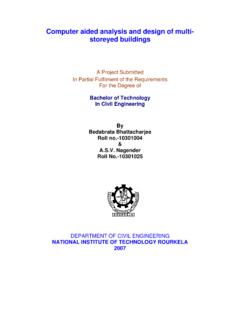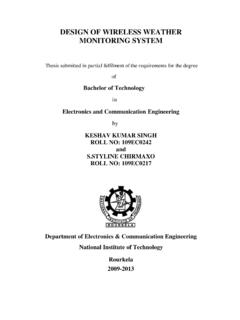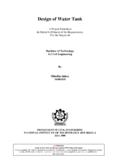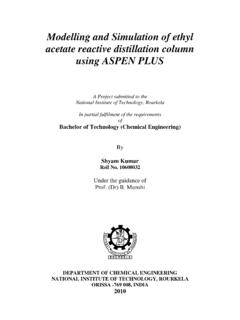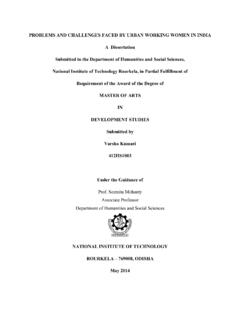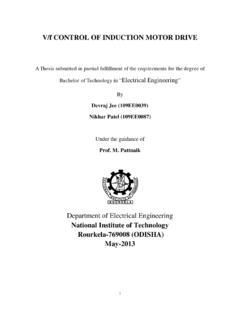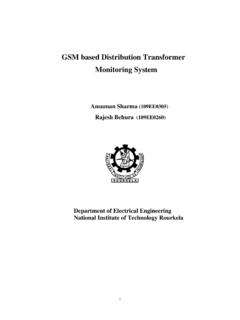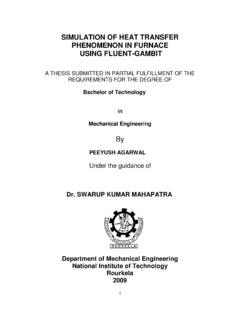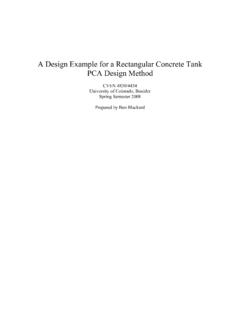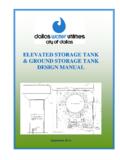Transcription of SEISMIC DESIGN OF ELEVATED TANKS - ethesis
1 SEISMIC DESIGN OF ELEVATED TANKS A PROJECT REPORT SUBMITTED IN PARTIAL FULFILLMENT OF THE REQUIREMENTS FOR THE DEGREE OF BACHELOR OF TECHNOLOGY IN CIVIL ENGINEERING BY MANORANJAN SAHOO (Roll Nos. 10301017) AND TANDRITA BISWAS (Roll No. 10301020) DEPARTMENT OF CIVIL ENGINEERING NATIONAL INSTITUTE OF TECHNOLOGY ROURKELA 2007 SEISMIC DESIGN OF ELEVATED TANKS A PROJECT REPORT SUBMITTED IN PARTIAL FULFILLMENT OF THE REQUIREMENTS FOR THE DEGREE OF BACHELOR OF TECHNOLOGY IN CIVIL ENGINEERING BY MANORANJAN SAHOO (Roll No. 10301017) AND TANDRITA BISWAS (Roll No. 10301020) UNDER THE GUIDANCE OF PROF. RATH DEPARTMENT OF CIVIL ENGINEERING NATIONAL INSTITUTE OF TECHNOLOGY ROURKELA 2007 i NATIONAL INSTITUE OF TECHNOLOGY ROURKELA CERTIFICATE This is to certify that the Project Report entitled SEISMIC DESIGN Of ELEVATED TANKS submitted by mr. manoranjan sahoo and miss tandrita biswas in partial fulfillment of the requirements for the award of Bachelor Of Technology Degree in Civil Engineering at the National Institute Of Technology, Rourkela (Deemed University) is an authentic work carried out by them under my supervision and guidance.
2 To the best of my knowledge, the matter embodied in this Project Report has not been submitted to any other University/Institute for the award of any Degree or Diploma. Date: Prof. Rath Department Of Civil Engineering National Institute Of Technology Rourkela-769008 ii ACKNOWLEDGEMENTS We extend our deep sense of gratitude and indebtedness to our guide Prof. B. K. Rath, Department Of Civil Engineering, National Institute Of Technology, Rourkela for his kind attitude, invaluable guidance, keen interest, immense help, inspiration and encouragement which helped us carrying out our present work. We are extremely grateful to Prof. Patra, Professor and Head of the Department of Civil Engineering and Prof. Pani, Student Advisor and the faculty members of Civil Engineering Department, National Institute of Technology, Rourkela, for providing all kind of possible help throughout the two semesters for the completion of this project work. It is a great pleasure for us to acknowledge and express our gratitude to our classmates and friends for their understanding, unstinted support and endless encouragement during our study.
3 Lastly, we thank all those who are involved directly or indirectly in completion of the present project work. TANDRITA BISWAS MANORANJAN SAHOO Roll No. 10301020 Roll No. 10301017 iii CONTENTS SERIAL NO. TOPIC PAGE NO. 1. ABSTRACT v 2. LIST OF FIGURES vii 3. LIST OF TABLES viii 4.
4 INTRODUCTION 1 5. PERFORMANCE OF ELEVATED TANKS 4 6. FRAME TYPE STAGINGS 6 7. COMPARISON OF DESIGN FORCES FROM VARIOUS CODES 8 8. PROVISIONS OF INDIAN CODE 13 9. DESIGN OF INTZE TANK 18 10. DISCUSSIONS AND CONCLUSIONS 26 11. REFERENCES 30 12. APPENDIX 31 iv SEISMIC DESIGN OF ELEVATED TANKS MANORANJAN SAHOO and TANDRITA BISWAS SUPERVISION: Prof. Rath ABSTRACT In this study, Wind Force and SEISMIC forces acting on an ELEVATED water tank Intze Tank are studied.
5 SEISMIC forces acting on the tank are also calculated changing the SEISMIC Response Reduction Factor(R). IS: 1893-1984/2002 for SEISMIC DESIGN and IS: 875-1987(Part III) for wind load has been referred. Then checked the DESIGN of Intze Tank by using the software STAAD PRO. An Earthquake is a phenomenon that results from and is powered by the sudden release of stored energy in the crust that propagates SEISMIC waves. At the Earth's surface, earthquakes may manifest themselves by a shaking or displacement of the ground and sometimes tsunamis, which may lead to loss of life and destruction of safety of liquid TANKS is of considerable importance. Water storage TANKS should remain functional in the post earthquake period to ensure potable water supply to earthquake-affected regions and to cater the need for fire fighting demand. Industrial liquid containing TANKS may contain highly toxic and inflammable liquids and these TANKS should not loose their contents during the earthquake.
6 The current DESIGN of supporting structures of ELEVATED water TANKS are extremely vulnerable under lateral forces due to an earthquake as it is designed only for the wind forces but not the SEISMIC forces. The strength analysis of a few damaged shaft types of stagings clearly shows that all of them either met or exceeded the strength requirement of IS: 1893-1984 however they were all found deficient when compared with requirements of International Building type stagings are generally regarded superior to shaft type of stagings for lateral resistance because of their large redundancy and greater capacity to absorb SEISMIC energy through inelastic actions. Various Codes have been considered and the maximum value of the ratio of base shear coefficient of tank to building, (BSCtank / BSCbldg) is about 3 to 4 in all the codes, as against a value of 6 to 7 for low ductility TANKS . This implies that DESIGN base shear for a low ductility tank is double that of a high ductility tank.
7 V Indian Standard IS: 1893-1984 provides guidelines for earthquake resistant DESIGN of several types of structures including liquid storage TANKS . This standard is under revision and in the revised form it has been divided into five parts. First part, IS 1893 (Part 1): 2002; which deals with general guidelines and provisions for buildings has already been published. Second part, yet to be published, will deal with the provisions for liquid storage TANKS . In this section, provisions of IS: 1893-1984 for buildings and TANKS are reviewed briefly followed by an outline of the changes made in IS 1893 (Part 1): 2002. Any DESIGN of water TANKS is subjected to Dead Load + Live Load and Wind Load or Earthquake load as per I S Code of Practice. Most of the times TANKS are designed for Wind Load and not even checked for Earthquake load assuming that the TANKS will be safe under Earthquake Loads once designed for Wind Loads. However present observation on the earthquake at Bhuj has shown that this TANKS must have been designed for Wind Loads but did not stand Earthquake Load.
8 Keeping this in view two Intze TANKS are designed with different specifications are studied by taking into account the provisions of 1893:2002 and for ELEVATED Tank 1893:1984 as well as NICEE suggestions and the results are presented. We have concluded that there is no uniformity in type of TANKS described in various documents. All documents suggest consideration of Convective and Impulsive Components in SEISMIC analysis of TANKS . Ratio of Base Shear of tank and building is 6 to 7 for low ductility TANKS and 3 to 4 for high ductility TANKS . Suitable provisions for lower bound limit on spectral values for TANKS are necessary. Indian Code needs to include provisions on lower bound limit on spectral values of buildings and TANKS and also Convective Mode of vibration in the SEISMIC analysis of TANKS . Based on the review of various International Codes, it is recommended that IS 1893 should have values of R in range of to for different types of TANKS . R Value taken in IS 1893:1984 is nowhere in the range corresponding to that value in different international codes.
9 Base Shear and Base Moment increases from Zone 3 to Zone 4 to Zone 5. With the increase in R value Base Shear and Base Moment decreases. Considering the DESIGN aspect, the SEISMIC forces remain constant in a particular Zone provided the soil properties remain same whereas the Wind force is predominant in coastal region, but in interior region earthquake forces are more predominant. For R= and , column size (450 mm) and reinforcements (8,25 bar) remain same but for R= , column size increases to 500 mm and reinforcements change to 8, 20 bar. Using STAAD PRO also we got the same values. vi LIST OF FIGURES: SERIAL NO. FIGURE NO. DESCRIPTION PAGE NO. 1 Figure World Map Showing The Epicenters 1 2 Figure An Iso-seismal Map 2 3 Figure Different Earthquake Zones Of India 3 4 Figure Collapsed 265 kL water tank in Chobari Village about 20 Km from the epicenter of Bhuj Earthquake 5 5 Figure Flexural cracks in staging of 500 kL tank being repaired by injecting epoxy.
10 This tank in Morbi, 80km away from the epicenter, was empty at the time of the earthquake 5 6 Figure Poor detailing of column-brace joints 6 7 Figure Comparison of base shear coefficient for ductile building obtained from various codes. Most severe zone in each code is considered 8 8 Figure Comparison of base shear coefficient for ground supported unanchored concrete water tank obtained from various codes. Most severe zone in each code is considered 9 9 Figure Comparison of ratio of base shear coefficients of tank and building from various codes (Low ductility tank) 10 10 Figure Comparison of ratio of base shear coefficient of tank and building from various codes (High ductility tank) 11 11 Figure Comparison of base shear coefficient for convective mode 12 12 Figure Base shear coefficients for TANKS from IBC 2000, IS 1893:1984 and IS 1893(Part1): 2002 12 13 Figure Comparison of BSC of Building obtained from IS Codes & IBC 2000 15 14 Figure Base Shear Coefficients for TANKS from IBC 2000, IS 1893:1984 and IS 1893(Part 1): 2002.
